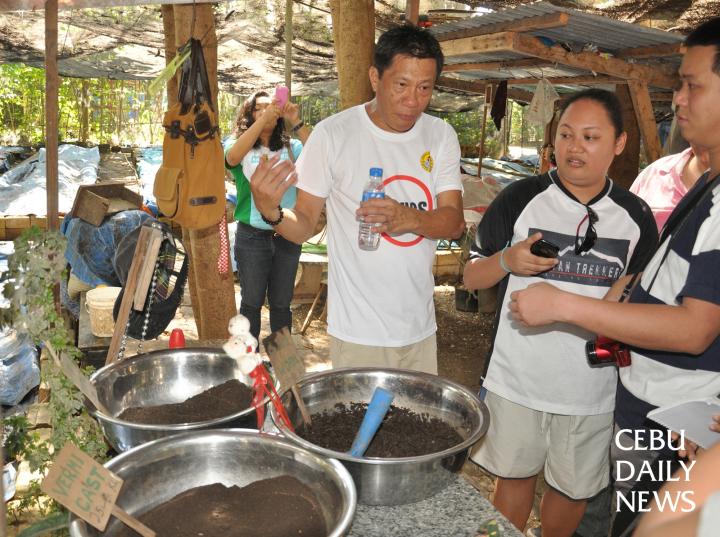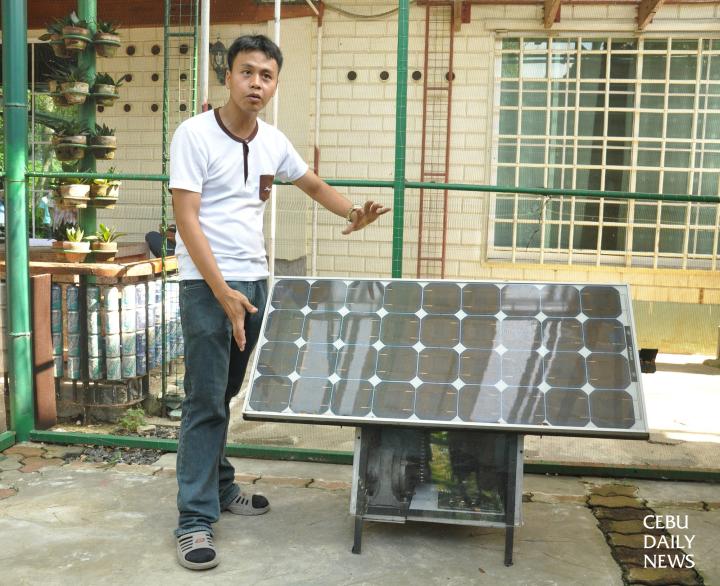House built from scrap proves green living
Common sense, he said, dictated him to build his house the way it is
Cebu City Councilor Nestor Archival is once again making a pitch for every household to manage their waste properly.
Yesterday, he gave journalists a tour of his eco-house in sitio Ylaya in barangay Talamban, Cebu City where he showed that he walks his talk when it comes to green living.
Archival’s ecohouse sits on a 7,000 square meter lot and was built using recycled materials. It could sustain its own power and water needs.
Columns of aluminum softdrink cans repurposed as balusters line the house’s terrace while metallic silver sheets that were placed as ceiling insulation turned out to be juice packs.
Rabi Abendan, the councilor’s secretary, said the cool atmosphere inside the house was not due to an air-conditioner. Abendan said the free flow of natural air inside the house was because of the way the ventilation system was designed.
The furniture in the living room were also crafted from discarded items. A wooden cable roller was recast into a coffee table which was adorned with a lamp shade that was made of dried urchin.
The flooring was also made of discarded wooden planks.
Renewable energy
The electricity needs of the house is supplied by 40 panels of solar panels capable of generating 10 kilowatts of power. Archival also has windmills that serve as back up to his solar generator.
His solar energy system can power four air-conditioners as well as all electrical appliances used in the house.
The kitchen’s stove uses methane gas processed by a bio-digester from human and animal waste.
A rain catchment system enables Archival to use rainwater to fill up his swimming pool, to flush toilets and for watering plants.
Fish lagoon
Guests in Archival’s ecohouse would be attracted to a Christmas tree made from wine bottles.
The open bottles positioned upwards would serve as the mosquitoes’ breeding den during rainy season. Before the mosquito larvae matures, workers in Archival’s house empties the wine bottles into a lagoon where tilapia is being raised. The mosquito larvae is good food for the tilapias.
The water of the lagoon is also used to water the plants.
Archival said the fishes in the lagoon are not fed with feeds. Algal growth in the water and insects attracted by violet light he installed near the water attracts insects. The algae and the insects serve as fish food.
Vermiculture

Councilor Nestor D. Archival explains composting earthworms to create vermicast. Vermicast is the end-product of the breakdown of organic matter by an earthworm. (CDN PHOTO/ CHRISTIAN MANINGO)
The biodegradable waste produced by the household goes to a compost pit.
Having a compost pit, he said is important in keeping insects outside the house.
He discourages putting garbage bins below the sink as it attracts cockroaches and rats.
Archival has 50 beds of horizontal compost pit with nocturnal earthworn worms.
The worms eat the biodegradable waste to produce high nutrient organic fertilizer known as vermicast.
Archival would sell the vermicast for P25 per kilo.
At the rooftop of his ecohouse, a vegetable garden was also found. Spring onions, Parsely, Basil, Papaya, Spinach and Ampalaya were planted horizontally and vertically.
Livestock
Also found inside Archival’s house are farm animals like chickens and goats. Abendan said they feed chickens with green leafy vegetables like kangkong and camote tops. They grow these leafy vegetables in recycled plastic cans filled with vermi soil.
The goats, on the other hand are fed rotten vegetables from the wet and dry market in the city.
Archival also makes bricks out of recycled plastic, He said he would add 15 percent plastic to the ingredients of making bricks.
Ecohouse for sale
A few meters away from his ecohouse, is another ecohouse. The ecohouse is 150 square meters. Of it 48 square meters is for living quarters, 35 square meters for garage and the remaining 20 square meters is the garden.
Archival said all in all the cost of his 150 square meter ecohouse is P5.5M.
Asked what inspired him to make his ecohouse, he said: Common sense.
Disclaimer: The comments uploaded on this site do not necessarily represent or reflect the views of management and owner of Cebudailynews. We reserve the right to exclude comments that we deem to be inconsistent with our editorial standards.


